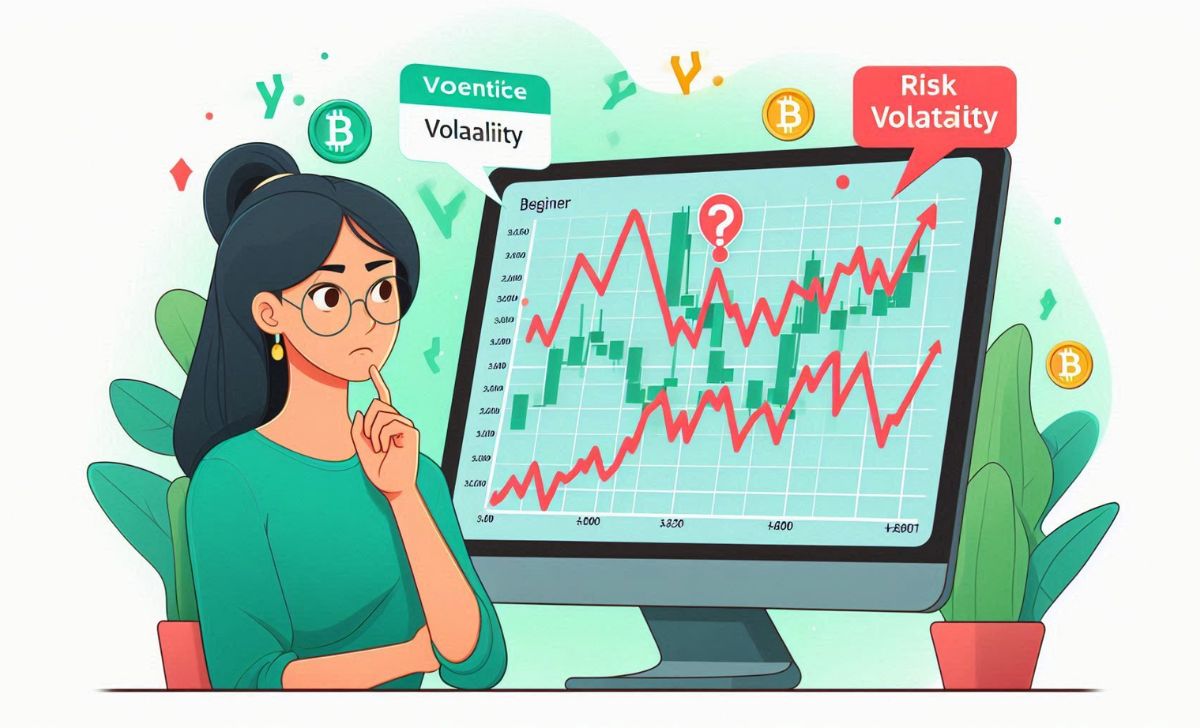Volatility crypto, marked by rapid and unpredictable price swings, has become a defining feature of the cryptocurrency market. You might be curious about essential information and beginner-friendly guidance on how to navigate it? In the article below, TopCoin9 will help you understand it all clearly.
What is Volatility Crypto?

In the simplest terms, volatility in crypto refers to how much and how quickly the price of a cryptocurrency moves up or down. A coin with large price swings over short periods is considered highly volatile. This is why many people are drawn to volatility crypto assets — the potential for high returns is enticing.
Unlike traditional markets, crypto market volatility is more intense due to lower liquidity, speculation, and emotional trading behavior. Bitcoin, Ethereum, and especially the most volatile crypto tokens like PEPE or FLOKI can experience dramatic price shifts within hours.
Now that we’ve defined what volatility means in crypto, let’s look at what causes it.
What Causes Crypto Volatility?
Several factors make volatility crypto assets prone to rapid price changes:
- Market Sentiment: Investor emotions like fear or greed play a huge role in crypto market volatility.
- Regulatory News: Announcements from governments or global financial institutions can spark major movements.
- Whale Activity: A single trade from a large holder can shift the price significantly.
- Liquidity Issues: Coins with low trading volume often show higher price instability, contributing to volatility in crypto.
The combined effect of these elements creates a perfect storm for price fluctuation — especially among the most volatile crypto assets.
With all these drivers in mind, how do we measure crypto volatility?
How to Measure Volatility in Crypto

Understanding volatility in crypto isn’t just about observing price swings — it’s about using measurable data to assess how unstable or dynamic a digital asset truly is. Knowing how to measure this volatility is essential for anyone looking to make smarter investment decisions, especially in a market as fast-moving and unpredictable as crypto.
Standard Deviation
One of the most common methods to measure crypto market volatility is by calculating the standard deviation of a coin’s price over a specific period. This statistical measure shows how much the price deviates from its average.
- High standard deviation = high volatility (frequent and large price swings).
- Low standard deviation = low volatility (price remains stable).
For example, a most volatile crypto asset like PEPE or DOGE might show extremely high standard deviation over just a few days, compared to a more stable asset like Bitcoin.
Average True Range (ATR)
ATR is another technical tool used to gauge volatility crypto. It measures the average range between a coin’s high and low price over a set number of days (usually 14).
- A rising ATR indicates increasing volatility.
- A falling ATR suggests that the asset is becoming more stable.
This tool is useful for day traders who want to know how much an asset typically moves within a single trading session.
Bollinger Bands
Bollinger Bands are a popular visual tool to assess crypto market volatility. They consist of a moving average with upper and lower bands that expand or contract depending on price movement.
- When the bands widen, it signals increased volatility.
- When the bands tighten, it suggests a calm or consolidating market.
Traders often monitor most volatile crypto tokens using Bollinger Bands to identify breakout opportunities.
Volatility Indexes and Metrics
While the crypto market doesn’t have a universal VIX (Volatility Index) like traditional markets, some platforms and analytics tools offer their own volatility indexes based on historical and real-time data. These indexes provide a quick overview of overall volatility in crypto, which is especially useful for portfolio planning and integration into your preferred crypto portfolio tracker.
Volume Analysis
Though not a direct measure, trading volume often correlates with volatility. Sudden spikes in volume usually indicate an increase in volatility crypto, as more traders are buying and selling due to news, hype, or fear.
With measurement tools in hand, is this volatility a friend or a foe for beginners?
Is High Volatility Good or Bad for Beginners?

When stepping into the world of cryptocurrencies, many beginners are immediately struck by how fast prices can rise — and fall. This rapid movement, known as volatility crypto, creates both opportunity and risk. But is high volatility really a good or bad thing for those just starting out?
The Pros of High Crypto Volatility
For beginners looking to grow their portfolios quickly, crypto market volatility offers unique advantages:
- High Earning Potential: Sudden price swings in volatile crypto assets can generate impressive profits in a short time. A well-timed trade on one of the most volatile crypto coins could potentially double or triple an investment.
- Frequent Trading Opportunities: With constant price changes, there are always chances to buy low and sell high — even within a single day.
- Learning Fast: Beginners exposed to high volatility often learn faster about technical analysis, market psychology, and risk management due to the fast-paced environment.
However, these benefits come with serious risks that shouldn’t be underestimated.
The Cons of High Crypto Volatility
The same traits that make volatility crypto appealing can also make it dangerous, especially for newcomers:
- Unpredictable Losses: Prices can drop just as fast as they rise. Without proper strategy, beginners can lose large portions of their capital.
- Emotional Stress: High crypto market volatility often triggers fear and greed, causing impulsive decisions and panic selling.
- Difficult for Long-Term Planning: For those investing with long-term goals, extreme volatility can make it hard to stick to a strategy or avoid emotional reactions.
Additionally, understanding regional crypto tax regulations is important, as unexpected gains (or losses) due to volatility could have tax implications depending on where you live.
The key to success lies in strategy. Let’s look at how beginners can navigate crypto volatility wisely.
Tips to Handle Crypto Volatility as a Beginner

Navigating the ups and downs of the crypto market volatility can feel overwhelming, especially for newcomers. However, with the right mindset and strategies, beginners can not only survive but also thrive in the volatile world of cryptocurrency.
Start Small and Use Risk Capital Only
When dealing with volatility crypto, always begin with an amount you can afford to lose. Avoid using money set aside for essentials like rent or savings. Crypto trading is inherently risky, especially with the most volatile crypto assets, and beginners should treat it as a learning experience. If you’re planning to buy crypto, start with small amounts and gradually build confidence as you learn the market.
Educate Yourself Continuously
Learn the basics of technical analysis, crypto liquidity, and crypto tax obligations. Understanding the ecosystem can save you from making costly mistakes.
Diversify Your Portfolio
Don’t put all your funds into one coin — especially not the most volatile crypto tokens. Spread your investments across different asset types, including more stable options like Bitcoin or Ethereum, and consider including non-crypto investments as well. Diversification reduces the impact of one asset’s extreme movement.
Avoid Emotional Trading
Volatility can trigger strong emotions like fear and greed. Beginners often make the mistake of buying high during hype and selling low during panic. Set clear entry and exit points for each trade, and stick to your plan, even when crypto market volatility shakes your confidence.
Use Stop-Loss and Take-Profit Orders
Stop-loss orders automatically close your trade when prices drop to a certain point, limiting potential losses. Take-profit orders do the opposite — locking in gains when a price target is hit. These tools are crucial for managing risk in volatility crypto environments.
Think Long-Term
The crypto market may swing wildly in the short term, but many successful investors profit by holding over longer periods. Instead of chasing the most volatile crypto for quick gains, focus on projects with solid fundamentals and real-world use cases.
Stay Updated with Reliable Sources
News events can instantly impact crypto market volatility — from regulatory announcements to major hacks or partnerships. Follow trusted crypto news platforms to stay informed, and consider setting up alerts for the assets you’re tracking.
Understanding volatility crypto is essential for making informed trading decisions and minimizing emotional reactions to market swings. Whether you’re navigating the most volatile crypto assets or monitoring overall crypto market volatility, knowledge and preparation are your best allies. Stay updated with reliable insights and beginner-friendly guides at TopCoin9, your trusted companion in the crypto world.

As a certified blockchain security expert with over 8 years in cybersecurity, James Anderson specializes in auditing smart contracts and identifying vulnerabilities in DeFi protocols. His expertise ensures that TopCoin9 delivers reliable insights on blockchain security and risk management.
Email: [email protected]












